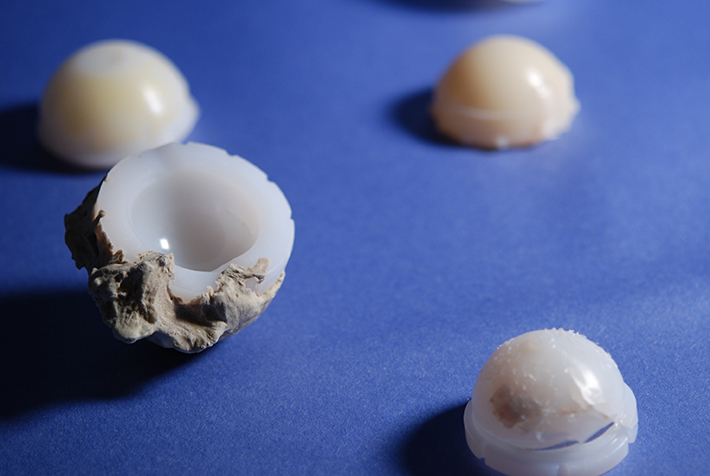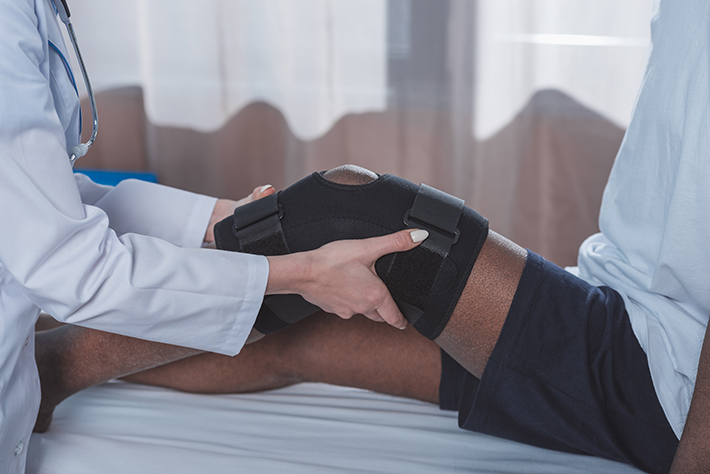
Standards and Artificial Joints
Since UHMWPE — ultra-high molecular weight polyethylene — came into regular medical use, the medical world has not looked back.
Decades later, with a few significant changes, the material continues to be the “gold standard” for artificial joint surfaces because of its wear resistance and fracture toughness. Each year, more than a million total joint replacements are made. Most devices, especially hips, use UHMWPE for articulating surfaces (a component in an implant assembly that also uses metal). And in the common, cross-linked form used for medical devices today, ASTM International standards guide its testing and use.
Medical Devices and Plastic
In the mid-20th century, plastic came into use for medical products, offering flexibility and chemical resistance for devices from catheters to joints and for equipment from labware to large diagnostic equipment.
With the development of polyethylene, a particular form — UHMWPE — would become an option for medical devices. Orthopaedic surgeon Dr. John Charnley, who some call the father of modern hip replacement, introduced the use of bone cement. He also first used UHMWPE clinically as part of a total joint replacement in 1960.
READ MORE: Standards for Medical Face Masks and Protective Clothing
In the late 1980s and into the 1990s, as researchers enhanced PE and the form known as UHMWPE, relevant ASTM International standards were developed and revised to reflect its evolution.
One of the first standards in this area was the specification for ultra-high-molecular-weight polyethylene powder and fabricated form for surgical implants (F648). First published in 1980 and still in use today, many subsequently developed standards refer back to this one, and the responsible polymeric materials subcommittee (F04.11) has revised it several times to reflect scientific development.
Jon Moseley, Ph.D., is senior director of applied research at Wright Medical Technology in Memphis, Tennessee, and current producer vice-chair of the committee on medical and surgical materials and devices (F04), as well as chair of its polymeric materials subcommittee (F04.11). He notes that the largest evolution in UHMWPE, one that researchers all over the world have worked on, is cross-linking of the material, primarily by radiation. This essentially means that its extremely long molecule chains connect in ways that make the material more durable, one of the most important needs for the movement of an artificial hip or knee replacement.
“Researchers in the mid 1990s discovered that when you cross-linked it, there was a huge improvement in the wear of the material,” Moseley says. “The rate of wear went down significantly. That probably represents the biggest single improvement in the processing and handling of the material over the last several decades that has occurred.”
“Today, all the commercial forms are based on this type of technology,” says Steven Kurtz, Ph.D., principal at Exponent and a research professor and director of the Implant Research Center at Drexel University, Philadelphia, Pennsylvania. He is also a member of F04.
 The use of plastics revolutionized the field of artificial joint replacement.
The use of plastics revolutionized the field of artificial joint replacement.
Kurtz explains another step in UHMWPE evolution: after radiation, a thermal step would be used to help stabilize the material. Alternatively, an antioxidant could be used for stabilization.
“It’s amazing to me to think about something like that — a natural antioxidant, Vitamin E — being so important in this context,” says Kurtz. “If you use it with cross-linking, that’s one way of developing a material that is going to have wear resistance and potentially last a long time in the body as well.” This type of second-generation, cross-linked material appeared after 2005. “And so then we wrote the antioxidant materials into the standards,” Kurtz adds. And along the way, a frequently used and problem additive, calcium sterate, was eliminated as well.
“This way, you were able to get the high wear resistance coupled with the improved resistance to oxidation of these materials without sacrificing mechanical properties,” says Stephen Spiegelberg, Ph.D., president of Cambridge Polymer Group, Charlestown, Massachusetts, and secretary of the F04 committee. According to Spiegelberg, as the understanding of the material has increased, the committee has developed and changed standards for the material parameters and tests to predict their efficacy.
William Mihalko, M.D., Ph.D., is an orthopaedic surgeon at the Campbell Clinic, Memphis, Tennessee, a professor at the University of Tennessee, and a former F04 chair. He notes, “The evolution of cross-linked UHMWPE has been a game changer for patients. Surgeons now utilize this as a standard in hip-replacement surgery, and aseptic loosening and wear have seen significant declines as reasons for revision surgery over the last two decades.”
The Standards
“The standards that have been developed for ‘ultra high’ are the result of all the competitors out there — the orthopaedic manufacturers, the consolidators, and others — willingly providing information to the general population. It’s really an altruistic approach, creating these standards to create a better material for the public good,” says Spiegelberg. (See list at bottom.)
Jack Lemons, Ph.D., professor emeritus at the University of Alabama-Birmingham and an ASTM International member since 1974, recalls that as polyethylene became routine for articulating surfaces on joints, relevant standards were developed in the medical devices (F04) and plastics (D20) committees. With testing on ceramics, polyethylene would be a control material to check for compatibility. Lemons notes that the PE documents evolved several times in response to issues associated with uses such as articulating surfaces in total joint arthroplasty, including particulates and in vivo foreign body reactions.
“Standards from the 1970s were test methods from the medical and plastics committees related to plastics, including PE,” Lemons says. “Polyethylene has always been available in many forms and chemistries, and made through many processes.”
FOR YOU: Surrogates and the Fight Against COVID-19
“The standards are like the yardsticks that everyone measures the material against. So they’re woven into the natural discourse about the material,” Kurtz adds.
Spiegelberg says, “A lot of the standards are application non-specific and cover the material itself.” Then there are standards that are specific to the actual devices, including a push-out test and wear tests for artificial hips — or specific tests for knee joints.
There are also related standards for the material, which is used in sutures (the specification for medical-grade ultra-high molecular weight polyethylene yarns, F2848). The practice for retrieval and analysis of medical devices, and associated tissues and fluids (F561), which includes devices made of UHMWPE, is another area governed by regulations.
Kurtz notes, “The U.S. Food and Drug Administration [FDA] expects that a retrieval analysis will be done when you revise or take out an implant. As part of a clinical trial, you are expected to take the device out and perform an analysis of it. Having an ASTM protocol for that is extremely helpful.”
Harmonizing and Regulating
An F04 group is working to harmonize the ASTM International standards with those developed by the International Organization for Standardization.
“International harmonization has become a lot more important in the last decade because companies are multinational,” Lemons says. He adds that related state, national, and international standards come from a number of organizations, including many from ASTM International.
In fact, standards from both groups are cited by the U.S. FDA in its guidance for orthopaedic device submissions: Characterization of Ultrahigh Molecular Weight Polyethylene (UHMWPE) Used in Orthopedic Devices. The ASTM standards above are included among those for testing wear, aging, and more.
Spiegelberg says the FDA process for recognizing a standard involves “an audit of a new standard that comes through and establishes whether or not they feel that’s a standard that they want people to be using for a specific application area. Once they recognize it and it’s published on their website, you as a producer of a material know that you can test to that standard, and the FDA should accept the results if you are in compliance with that standard.”
“The FDA guidance documents are very important in making sure that all in industry are consistent according to the same standards,” Moseley says. He adds that this is important as there is no standard cross-linked material, and each company makes it a little differently.
The Work Continues
While many of the UHMWPE standards are mature, and major developments such as crosslinking and antioxidants have been reflected for some time now, evolution continues.
One example is a proposed standard, the practice for pre-conditioning of ultra-high-molecular-weight polyethylene for accelerated aging (WK62790), now under way. Leading this work is Ebru Oral, Ph.D., associate professor of orthopaedic surgery at Harvard Medical School and associate director of the Harris Orthopaedic Laboratory, Massachusetts General Hospital, in Boston. In her lab, she says, she has been part of work investigating the effects of synovial fluid lipids — joint lubricants — on oxidation, which can ultimately impact the longevity of an implant in the body. The proposed standard will allow an investigator to pre-condition UHMWPE specimens as part of accelerated aging evaluations. “The standard will be another tool to evaluate polymeric materials,” Oral says.
And while work will continue on maintaining and refining UHMWPE standards, the responsible subcommittees continue to develop new methods and guides for other arthroplasty components.■
Sampling UHMWPE Standards
The most significant UHMWPE standards include:
- Practice for accelerated aging of ultra-high molecular weight polyethylene after gamma irradiation in air (F2003) describes how to evaluate the oxidative stability of UHMWPE materials through accelerated aging. The process furthers the understanding of a material’s long-term chemical and mechanical stability.
- Test method for in situ determination of network parameters of crosslinked ultra-high molecular weight polyethylene (UHMWPE) (F2214) shows the extent of the cross-linked network in the material and provides data useful for research, quality assurance, and dose uniformity analysis.
- Guide for extensively irradiation-crosslinked ultra-high molecular weight polyethylene fabricated forms for surgical implant applications (F2565) provides requirements for numerous characteristics, including ultimate tensile strength, yield strength, elongation, Izod impact strength, ultimate load, fatigue crack propagation, compressive modulus, percent crystallinity, melting temperature, residual free radicals, swell ratio, oxidation index, and t-vinylene content. This standard lays out the tests that should be done when making UHMWPE.
- Specification for ultra-high molecular weight polyethylene powder blended with alpha-tocopherol (Vitamin E) and fabricated forms for surgical implant applications (F2695) addresses material characteristics and not the packaged and sterilized finished implant.
- Guide for assessment of the ultra-high molecular weight polyethylene (UHMWPE) used in orthopedic and spinal devices (F2759) covers a range of assessments and evaluations for developing various UHMWPE components, data, processing conditions, and intended uses. Qualitative and quantitative analyses are also included.
- Test method for small punch testing of polymeric biomaterials used in surgical implants (F2977) uses miniature specimen techniques to characterize mechanical behavior from manufacture through implantation and for evaluations after simulated aging and fatigue testing.
 SN Home
SN Home Archive
Archive Advertisers
Advertisers Masthead
Masthead RateCard
RateCard Subscribe
Subscribe Email Editor
Email Editor